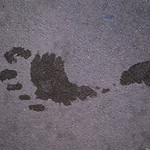Barefoot Running Effects on Injuries
Posted by Toran MacLeod PT, PhD on January 14, 2013

The Starting Line:
Can running barefoot help prevent running injuries?
Traditional running shoes have cushioning that allows for the comfortable rearfoot strike pattern present in 80% of runners. This rearfoot strike is associated with an impact spike in the vertical ground reaction force, which creates high loading rates within the leg. Over time, these repetitive loading events may lead to injuries such as stress fractures, patellofemoral pain, and plantar fasciitis.
Barefoot running – running without even minimalist or “barefoot” shoes – is a strategy adopted by some runners to avoid these high loading rates associated with the rearfoot strike pattern. Running without shoes makes landing on the bare heel uncomfortable, which enforces a switch to a forefoot strike pattern. Running barefoot also tends to reduce stride length, and the potential benefits of this have been described in a previous post on cadence manipulation. An article published in 2012 by Altman & Davis reviewed the evidence for barefoot/minimalist footwear versus more conventional running shoes and their implications for running injuries. On one hand, the modern running shoe attempts to correct for misalignment, attenuate shock, and protect the foot. On the other hand, barefoot running typically demands the runner adopt a forefoot strike pattern that reduces the impact peak/high loading rates and shortens the stride length. However, landing on the front of the foot, rather than the heel, creates greater loading and loading rates on the Achilles and posterior compartment muscles, and likely causes increased pressure on the bones of the foot. The minimalist shoe, that is meant to mimic barefoot running, does not always cause a shift to a forefoot strike pattern and doesn’t give the runner the increased sensory information from the ground.
Unfortunately, there are more unknowns than knowns associated with running barefoot. We do not know if there are more running injuries associated with shoe type, or if the injury types are just different. What is known is that switching to a barefoot running regimen too fast is a significant risk factor. However, we do not know the definitive best practice for a progressive transition. Runners that have had recurrent injuries (especially those typical for a rearfoot strike) might benefit from a switch; but changing shoe types in runners that are injury-free makes less sense.
The Finish Line:
Barefoot running is associated with a forefoot strike pattern, reduced stride length, and smaller impact peak in the vertical ground reaction force, which may be helpful for runners with injuries resulting from high loading rates.
References:
1. Altman AR, Davis IS. Barefoot running: biomechanics and implications for running injuries. Curr Sports Med Rep. 2012 Sep-Oct;11(5):244-50. http://www.ncbi.nlm.nih.gov/pubmed/22965347
Photo credit: gordontarpley via photopin cc
*Note: This general information is not intended to be a substitute for medical treatment or advice. Always consult a professional before making changes to your health and wellness practices.
Feedback or suggestions for future topics? Let us know!
